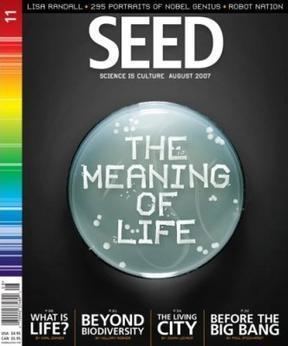Frequency Bimonthly Company Seed Media Group | Final issue— Number May/June 200922 | |
 | ||
First issue November 2001 (vol. 1)October/November 2005 (vol. 2) | ||
Seed (subtitled Science Is Culture; originally Beneath the Surface) is an online science magazine published by Seed Media Group. The magazine looks at big ideas in science, important issues at the intersection of science and society, and the people driving global science culture. Seed was founded in Montreal by Adam Bly and the magazine is now headquartered in New York with bureaus around the world. May/June 2009 (Issue No. 22) was the last print issue. Content continues to be published on the website.
Contents
Seed was a finalist for two National Magazine Awards in 2007 in the categories of Design and General Excellence (100,000 to 250,000), is the recipient of the Utne Independent Press Award, and is included in the 2006 Best American Science and Nature Writing anthology published by Houghton Mifflin and edited by Brian Greene.
The magazine publishes original writing from scientists and science journalists. Scientists who have contributed to the magazine include: James D. Watson, Freeman Dyson, Lisa Randall, Martin Rees, Steven Pinker, E.O. Wilson, and Daniel Dennett. Seed's design direction was created by Stefan Sagmeister. Jonah Lehrer also contributed features to Seed.
History
Bly's first incursion into media came in 2000, when he launched an online magazine, the Journal of Young Scientists (www.joysnet.com). He was previously a researcher at Canada's National Research Council. JoYS shared Seed's focus on the roles of science in many aspects of society, as well as its emphasis on design. Nobel laureate Leon M. Lederman was among the senior scientists who contributed to the magazine.
Founding the media group SEED Group, based in Montreal and funded privately, Bly started Seed's publication in Canada in November 2001. The magazine focused on the meeting of science and culture at its inception: Bly's first editor's note declared that "SEED defines the science of contemporary urban culture". In additional interviews, he explained that the magazine would connect to the reader by showing the widespread applications of science, as well as giving faces to "the people behind science" by placing people on the covers. The first issue had a circulation of 105,000 within the U.S. and Canada; popular science writer Matt Ridley was among the contributors.
In its design, Seed was self-declared as "science couture", with many pages where graphics outweighed text. The first cover featured a nude male-female couple and included pieces themed around birth. The Boston Globe described two interior pages in which "Above a pacifier image is an essay on fluids and engineering with curves. A purple balloon floats above a few sentences about the expanding universe." High fashion also permeated the magazine's advertising, which included "Hugo Boss, Kaluha [sic], Evian, Club Monaco, Absolut Citron, Kenzo, [and] Skechers" in the first issue; The Christian Science Monitor describes the juxtaposition of the graphic design as "often making it difficult to tell where the journalism ends and the sales pitches begin".
The first issue received coverage in both Science and Nature.
The last issue to be published was in February 2012, with no issues between May 2011 and February 2012.
Features
The magazine is laid out into the following sections, each separated by a portfolio of science photography:
